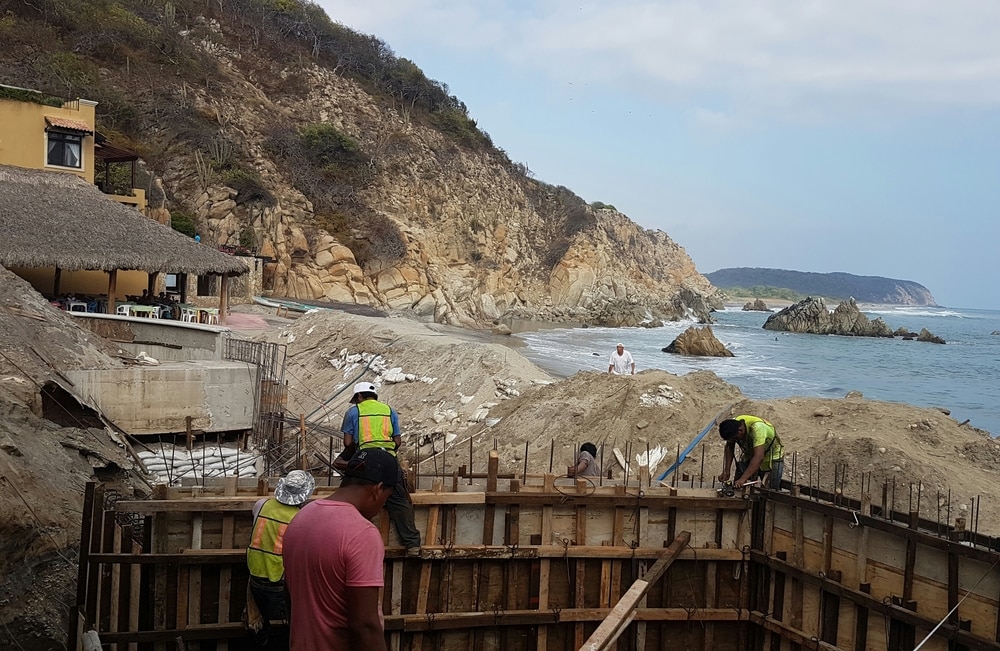Chapter 2 – Protective Waterfront Structures
For a complete version of this document click here.
2.1 Definitions
2.1.1 Seawall. A seawall is a soil retaining or armoring structure whose purpose is to defend a shoreline against wave attack. It differs from a breakwater in its capacity as a soil retention structure. Seawalls are forms of shore protection and are not intended for use as berthing facilities (refer to NAVFAC DM-26.2, Coastal Protection).
2.1.2 Bulkhead. A bulkhead is a soil retaining wall structure comprised of verticallyspanning sheet piles or other flexural members. Bulkheads derive their stability through mobilization of passive earth pressures between the mudline and embedded tip, and, in most cases, from a lateral restraint system installed between Mean Low Water (MLW) and top of the wall top. Bulkheads are installed to establish and maintain elevated grades along shorelines in relatively sheltered areas not subject to appreciable wave attack, and are commonly used as berthing facilities.
2.1.3 Quaywall. A quaywall is a gravity wall structure having the dual function of providing shore protection against light to moderate wave attack and a berthing face for ships. Its function is similar to a bulkhead but should be chosen when overall height requirements or wave environment severity exceed the practical capabilities of typical bulkhead constructions. Quaywalls differ from bulkheads and wall-type seawalls in that they do not necessarily retain a soil backfill.
2.2 Selection of Type of Facility. The boundaries of functional application between basic structure types are not well defined. Within the general definitions of each, there exists a wide variety of construction types and techniques, resulting in considerable overlap in wave resistance capacity and applicability. In general, selection among the basic forms for a particular application depends upon the severity of the wave environment, the physical requirements of the berth of the ship, if applicable, and the relative construction costs associated with each in the geographic area under construction.
2.2.1 Bulkheads vs. Seawalls. The terms “bulkhead” and “seawall” are frequently and inappropriately interchanged, and bulkheads are sometimes installed to serve as seawalls. The forces imposed by breaking or broken waves can be considerable and can prove to be irresistible to the flexible, multi-jointed sheet element construction inherent to bulkheads. Seawalls are required along exposed shorelines subject to attack by wave spectra defined by significant wave heights of 5 ft (1.52 m) or more. For shorelines exposed to lesser degrees of wave action, the decision between seawall and bulkhead construction will be based upon economics and land-use considerations. Where maximization of waterfront real estate is required, the vertical-wall construction of bulkheads is preferable. The finished grade elevation of the retained backfill can be established at or above the extreme high water line, and maintained immediately up to the shoreline. Where development of the waterfront is not anticipated and the lateral extent required by revetment
2.2.2 Bulkheads vs. Quaywalls. If a harbor is properly sited, protected, and designed, the contained berthing facilities will not be exposed to excessive wave action. Modern bulkhead construction techniques have extended their applicability into areas that, in the past, required quaywall installation. As such, bulkheads have virtually eliminated the necessity for quay walls in most harbors. However, there remain situations for which bulkheads are inappropriate. The maximum wall height that can be realistically accommodated by bulkhead construction is approximately 40 ft (12.1 m). Therefore, whenever the combination of dredge depth and backfill freeboard approaches or exceeds this general limitation, quaywall construction should be considered. Also, not all harbors are sited or protected adequately to preclude the possibility of moderate to severe wave attack. At these sites, quaywalls remain the most viable solution where a combination of berthing and shore protection is required.
-
 SPW911 Sheet Pile Design Software
Rated 5.00 out of 5$150.00 – $599.99
SPW911 Sheet Pile Design Software
Rated 5.00 out of 5$150.00 – $599.99 -
 Sheet Pile Design (PDF Download)
Rated 5.00 out of 5$89.00
Sheet Pile Design (PDF Download)
Rated 5.00 out of 5$89.00 -
 Pile Driving (PDF Download)
$89.00
Pile Driving (PDF Download)
$89.00
-
 Marine Construction Volumes 1 & 2 (PDF Download)
$157.00
Marine Construction Volumes 1 & 2 (PDF Download)
$157.00
-
 Pile Driving (Book)
$89.00
Pile Driving (Book)
$89.00










